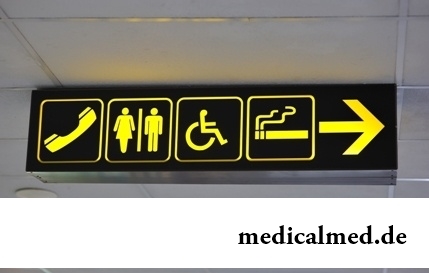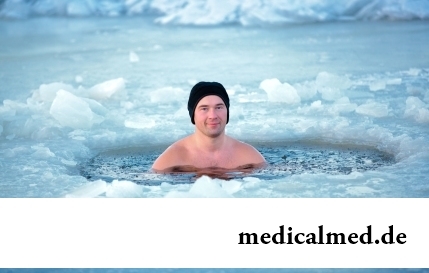





Alopecia
Alopecia (Latin alopecia, Greek alopekia; synonyms: baldness, атрихоз, an atrichia, a pelada, baldness) – temporary or permanent, partial or full loss (absence) of hair.
Types of an alopecia:
- Inborn (congenita) – resistant, develops since the birth;
- Inborn general (congenita totalis) – lack of hair on all integument;
- Inborn limited (congenita circumscripta; synonym: an atrichia spotty) – lack of hair on limited sites of an integument;
- Gnezdny (areata; synonyms: circular, focal) – a hair loss on one or several sharply limited roundish sites of skin;
- Gnezdny regional (areata marginalis; synonyms: Wilson a gnezdny alopecia, офиаз) – gnezdny with localization on peripheral sites of a pilar part of the head, a thicket – in a nape;
- Gnezdny cutting (areata tonsurans) – the atypical form of a gnezdny alopecia which is characterized by an oblamyvaniye of hair;
- Diffusion (diffusa) – a uniform poredeniye of hair;
- leprose (leprosa) – the symptomatic resistant alopecia which arose because of trophic frustration at patients with a leprosy;
- Linear rubtsuyushchy (cicatricalis linearis; synonym: Leventalya-Lyuri a linear rubtsuyushchy alopecia) – the family disease of an unknown etiology which is characterized by the centers of a persistent hair loss located linearly with formation of a hem;
- Melkoochagovy (parvimaculata) – the gnezdny alopecia which is characterized by the small sizes of the centers of baldness; it is observed in the form of epidemic flashes at children;
- Neurotic (neurotica; synonym: Michelson a neurotic alopecia) – the symptomatic alopecia arising at some diseases of a nervous system;
- Newborns occipital (occipitalis neonatorum) – traumatic passing, develops in occipital area at newborns at continuous lying on spin;
- The general (universalis; synonyms: generalized, universal) – total absence of hair on all integument;
- Premature (praematura; synonym: presenile) – not clear etiology, develops at persons of middle and young age, begins with parietal or frontal area;
- X-ray (roentgenica) – arises because of x-ray radiation; can be a rack (at a considerable exposure dose);
- Cicatricial (cicatricalis) – resistant, is caused by the cicatricial changes of skin which arose because of injuries or inflammatory processes;
- Seborrheal (seborrhoica) – diffusion, arises at seborrhea;
- Symptomatic (symptomatica) – develops as a complication or a symptom at any diseases, injuries of skin or intoxications;
- Syphilitic (syphilitica) – temporary, arises in the secondary period of syphilis because of the general intoxication or defeat of hair follicles;
- Syphilitic diffusion (syphilitica diffusa) – a form of an alopecia syphilitic with a diffusion hair loss it is preferential in temporal areas;
- Syphilitic melkoochagovy (syphilitica areolaris; synonym: an alopecia syphilitic ochazhkovy) – a form of an alopecia syphilitic with a set of the small roundish ochazhok located, mainly, in a nape, temples, eyelashes and eyebrows;
- Syphilitic mixed (syphilitica mixta) – a form of an alopecia of a melkoochagovy and diffusion alopecia, syphilitic with signs, syphilitic;
- Senile (senilis; synonym: senile) – resistant, develops because of a senile atrophy of hair follicles;
- Thallic (tallica) – passing, develops because of use of a thallic plaster at treatment of dermatomycoses;
- Toxic (toxica) – symptomatic, develops because of intoxication;
- Total (totalis; synonym: gnezdny malignant) – a generalized form of a gnezdny alopecia, leads to a full hair loss on all head, and sometimes and on other skin sites;
- Traumatic (traumatica; synonym: the Greenland) – arises because of continuous traumatizing certain sites of indumentum;
- Triangular (triangularis frontoparietalis) – a form of an inborn alopecia, has an appearance of the unilateral center of triangular shape in frontotemporal area;
- Epilinovy (epilinica) – passing, develops at use of an epilinovy plaster at treatment of dermatomycoses.
At regular visit of a sunbed the chance to develop a carcinoma cutaneum increases by 60%.

Water with a lemon - idle time in preparation drink which supporters of a healthy lifestyle already managed to appreciate. Upo...
Section: Articles about health
The saying "the rich do not know how the other half lives" is known to all. In a broad sense it is that we can not always understand the person whose features of a state are unknown to us. If with physiological characters of diseases the situation is more or less clearly (having noticed and...
Section: Articles about health
The words "disease" and "patient" not without reason come from one root – "pain". As a rule, symptoms of illnesses thoroughly spoil to patients life. However from this rule there are exceptions. Some diseases are shown by signs which can cause even positive emotions. It is a pity only that the majority of such illnesses are heavy and incurable....
Section: Articles about health
Frosty air, fresh wind and easy snowball at most of Russians are associated with cheerfulness, health and cheerful entertainments, on to...
Section: Articles about health
All got used long ago that, having addressed the plastic surgeon, it is possible to modify natural parameters of a figure or to minimize the damages put to appearance with ruthless time. Many people (preferential women) worldwide е...
Section: Articles about health
Cold – a state known to everyone which is followed by cold, cough, high temperature, a pharyngalgia. Often the first that we begin to do in hope again to become healthy – to accept medicines which are not always harmless whereas it is easy to facilitate displays of a disease by means of natural means. They not only softly eliminate disease symptoms, but also enrich the weakened organism with useful substances. We present you 8 drinks which are successfully used for...
Section: Articles about health
New year, wedding, birthday, office party – an occasion to drink at the Russian person will always be. How to reduce a negative impact...
Section: Articles about health
Nightmares belong to the most unpleasant frustration. Statistically, they happen at 4% of adults, and almost at 70% of children and teenagers. During a nightmare of people dreams himself in extremely difficult, life-threatening situation. It wakens suddenly, in...
Section: Articles about health
Extracorporal fertilization – one of the most modern methods of controlling with infertility. So far he already helped a significant amount of married couples to become happy parents. Usually to the EKO procedure difficult and very expensive, resort in those situations when all other ways to help couple to bring the child are inefficient. "Conception in a test tube" yields quite good results in cases of infertility of one of partners, existence at the woman of impassability of uterine tubes...
Section: Articles about health
It seems, quite recently you brought the baby from maternity hospital, but time flew by, and here it is already going to join the first...
Section: Articles about health
High temperature - a frequent symptom of such widespread diseases as a SARS, quinsy, pneumonia, etc. To reduce heat, having facilitated a condition of the patient, doctors recommend to accept antipyretics, however their use is not always possible. Too h...
Section: Articles about health
Bees – really unique beings. Practically all products of their life activity are used by the person. Since the most ancient times medicinal properties of honey and other substances received in the course of beekeeping are known. The fact that all these products are recognized not only national, but also official medicine is especially significant. About influence and routes of administration of bee "drugs" the speech in this article will also go....
Section: Articles about health
In consciousness of our many compatriots idea that folk remedies if no more эфф strongly took roots...
Section: Articles about health
Venereal diseases in medicine are called the infections which are transmitted preferential sexually, now they and are called - infections, sexually transmitted, or STD. Among them is also life-threatening. In spite of the fact that majority...
Section: Articles about health
It is possible to find the extensive range of fruit and vegetables in modern shops. Russians already got used that on counters there is not only a seasonal domestic production, but the vegetables and fruit which are grown up in the countries with more comfortable conditions of cultivation at all seasons of the year. However what we see in shops and in the vegetable markets, is only a small part of those edible plants with which the nature is so rich. Today we want to acquaint the reader with rare and very useful vegetables which on...
Section: Articles about health
EKO, or extracorporal fertilization - a method of treatment of infertility which became the reason of a set broken mines in due time...
Section: Articles about health
Scientists always aimed to offer fundamental explanations for medical problems. Their theories formed the basis of modern methods of treatment of the hardest pathologies and helped to save a set of lives. However stories are known also such theoretical constructions, following to...
Section: Articles about health
The drugs stopping or oppressing life activity of pathogenic microorganisms are widely applied in clinical practice from 40th years of the last century. Originally antibiotics were called only substances natural (animal, vegetable or microbic) origins, but over time this concept extended, and it includes also semi-synthetic and completely artificial antibacterial drugs....
Section: Articles about health
The body of the person almost for 60% consists of water. It is so important for normal functioning of an organism that loss of all is ponut...
Section: Articles about health
The stroke is one of the most widespread diseases of the person, annually in the world about 6 million cases of this pathology are registered. According to medical statistics, strokes occur almost three times more often than myocardial infarctions. Disease otno...
Section: Articles about health
You are office worker, the driver, the fan of winter sports or do not think of life without bicycle? You lead a slow-moving life and you move on the city only on the car? You have no constant partner and you do not love the protected sex? Attention! You unambiguously are a potential target for prostatitis. It is not necessary to panic, it is necessary to work....
Section: Articles about health
The business lady, the become mother, it is necessary to solve an array of problems. But of them is main: how to combine the beloved child and work?...
Section: Slideshow
The winter swimming in open reservoirs called in our country by "winter swimming" – officially recognized sport and one of the most extreme ways of a hardening of an organism. This occupation has an old story and adherents in many countries. Are annually carried out...
Section: Articles about health
The cosmetics intended for improvement of a condition of skin, nails and hair are used by each woman. Expenses on regular acquisition of the fashionable widely advertized products of well-known companies for many become very notable and significantly burden the family budget. Meanwhile, there is a number of inexpensive pharmaceutical drugs which can quite be applied in the cosmetic purposes. At the same time the effect of their use is often more noticeable, than result of use of the most expensive...
Section: Articles about health
It is impossible to imagine human life in which there would be no plants. Practically in each apartment and any of productions...
Section: Articles about health
The naturopathy sometimes moves as the new direction of medicine, something like fashionable hobby, and there is nothing farther from the truth. This most ancient direction, the word "naturopathy" is translated as "treatment by the nature", and, no doubt, treatment приро...
Section: Articles about health
For the help to doctors in the choice of optimal solutions for treatment of various diseases the Cochrane scientific organization (Cochrane) conducts joint researches with representatives of scientific community around the world. The analysis of a series of the conducted researches of the drug Oscillococcinum® relating to group of cold remedies became one of the last methanolyses....
Section: Articles about health
